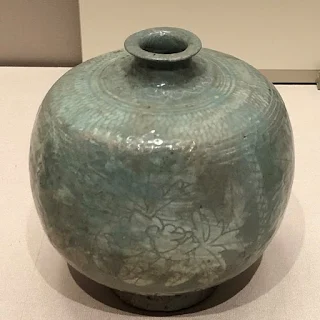This is Buncheong ware made in the 15th or 16th century in the Joseon dynasty, Korea. This stoneware features designs painted using an iron pigment and a bluish-green tone. It's not celadon, but its green color is very close to celadon and there is a reason for that.
 |
| Buncheong ware with sgrafitto peony design |
Buncheong ware is the in-between of celadon and white porcelain, rising to prominence during the 15th century in Korea. So it's understandable for its color to be like its predecessor, i.e., celadon, but sadly the stoneware just disappeared, being almost completely replaced by its successor, i.e., white porcelain.
It reminds me of the importance of embracing impermanence, making me look at this tranquil celadon blue green again.
 |
| Buncheong ware in 15th to 16th century Joseon dynasty, Korea |
Buncheong ware is known in Japan as "Mishima," "Hakeme" or "Kohiki." You can see this Buncheong ware with peony sgrafitto at Tokyo National Museum.
(If you wish to post your comment but don't have a Google account, select "anonymous" from the drop down menu titled "comment as"!)
東京国立博物館の粉青沙器。搔き落としの技法を使って牡丹が描かれています。粉青沙器とは、灰色の胎に白土を用いて様々な装飾を施したもので、高麗青磁と高麗白磁の中間に位置する磁器。ただ、白磁の出現とともに消滅してしまったとのこと。こんなに美しいのに残念です。
(Google アカウントを持ってない方がコメントする場合は、「Google アカウント」をクリックし、「匿名」か「名前/URL」を選択してからご記入ください!)


0 件のコメント:
コメントを投稿